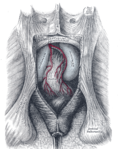Posterior inferior iliac spine
Posterior Inferior Iliac Spine
The posterior inferior iliac spine (PIIS) is a bony prominence located on the posterior aspect of the ilium, which is one of the three bones that make up the hip bone or pelvic girdle. It serves as an important attachment site for various muscles and ligaments involved in the movement and stability of the hip joint.
Anatomy
The PIIS is a small, pointed projection that extends posteriorly and inferiorly from the posterior border of the ilium. It is situated just below the larger and more prominent posterior superior iliac spine (PSIS). The PIIS can be palpated by placing the hand on the back of the hip and moving it downward and inward towards the midline.
Function
The PIIS serves as an attachment site for several muscles and ligaments, playing a crucial role in the stability and movement of the hip joint. Some of the important structures that attach to the PIIS include:
1. **Sacrospinous ligament**: This ligament originates from the PIIS and attaches to the sacrum. It helps to stabilize the sacroiliac joint, which is the joint between the sacrum and the ilium.
2. **Obturator internus muscle**: This muscle arises from the inner surface of the obturator membrane and the surrounding bony margins. It passes through the lesser sciatic foramen and attaches to the PIIS. The obturator internus muscle is responsible for the external rotation of the hip joint.
3. **Gemellus inferior muscle**: This muscle arises from the ischial tuberosity, passes through the lesser sciatic foramen, and attaches to the PIIS. It works in conjunction with the obturator internus muscle to assist in the external rotation of the hip joint.
4. **Quadratus femoris muscle**: This muscle originates from the ischial tuberosity and attaches to the PIIS. It is involved in the lateral rotation of the hip joint.
Clinical Significance
The PIIS can be a site of pain and discomfort in certain conditions. Inflammation or strain of the muscles and ligaments attached to the PIIS can result in posterior hip pain. This can occur due to overuse, trauma, or underlying conditions such as tendinitis or bursitis.
In addition, the PIIS can be used as a landmark for various clinical procedures. For example, during a sacroiliac joint injection, the PIIS can be palpated to locate the appropriate site for the injection. It can also be used as a reference point for identifying other anatomical structures in the pelvic region.
References
1. Standring, S. (Ed.). (2016). Gray's Anatomy: The Anatomical Basis of Clinical Practice (41st ed.). Elsevier.
2. Drake, R. L., Vogl, W., & Mitchell, A. W. M. (2014). Gray's Anatomy for Students (3rd ed.). Elsevier.
See Also
Posterior inferior iliac spine
Transform your life with W8MD's budget GLP-1 injections from $125.
W8MD offers a medical weight loss program to lose weight in Philadelphia. Our physician-supervised medical weight loss provides:
- Most insurances accepted or discounted self-pay rates. We will obtain insurance prior authorizations if needed.
- Generic GLP1 weight loss injections from $125 for the starting dose.
- Also offer prescription weight loss medications including Phentermine, Qsymia, Diethylpropion, Contrave etc.
NYC weight loss doctor appointments
Start your NYC weight loss journey today at our NYC medical weight loss and Philadelphia medical weight loss clinics.
- Call 718-946-5500 to lose weight in NYC or for medical weight loss in Philadelphia 215-676-2334.
- Tags:NYC medical weight loss, Philadelphia lose weight Zepbound NYC, Budget GLP1 weight loss injections, Wegovy Philadelphia, Wegovy NYC, Philadelphia medical weight loss, Brookly weight loss and Wegovy NYC
|
WikiMD's Wellness Encyclopedia |
| Let Food Be Thy Medicine Medicine Thy Food - Hippocrates |
Medical Disclaimer: WikiMD is not a substitute for professional medical advice. The information on WikiMD is provided as an information resource only, may be incorrect, outdated or misleading, and is not to be used or relied on for any diagnostic or treatment purposes. Please consult your health care provider before making any healthcare decisions or for guidance about a specific medical condition. WikiMD expressly disclaims responsibility, and shall have no liability, for any damages, loss, injury, or liability whatsoever suffered as a result of your reliance on the information contained in this site. By visiting this site you agree to the foregoing terms and conditions, which may from time to time be changed or supplemented by WikiMD. If you do not agree to the foregoing terms and conditions, you should not enter or use this site. See full disclaimer.
Credits:Most images are courtesy of Wikimedia commons, and templates, categories Wikipedia, licensed under CC BY SA or similar.
Contributors: Prab R. Tumpati, MD


